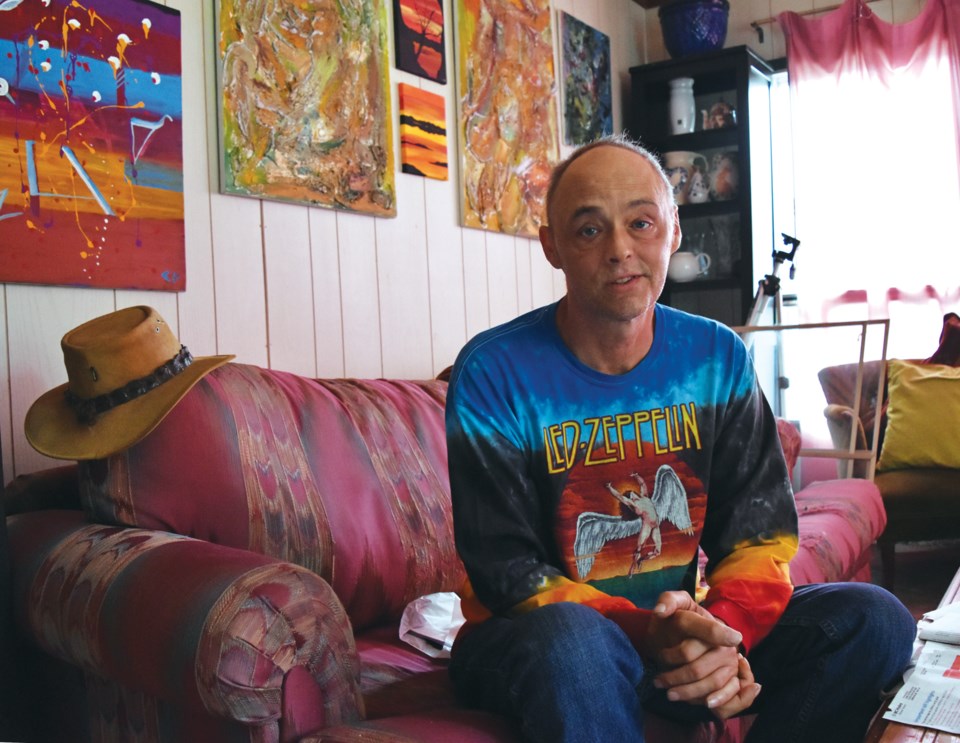A 55-year-old man celebrated a new kind of birthday on Wednesday.
“I’m completely feeling like I’m reborn,” said Carl Pendleton from his home at Poplar Estates outside of Gibsons.
July 31 marks the anniversary of his successful bone marrow transplant, which he received from an anonymous donor. Now he wants to spread the word for people to register with Canadian Blood Services.
Pendleton was diagnosed with myelodysplastic syndrome in 2016, a form of cancer that prevents the body from producing healthy blood cells. He was given between three months and three years to live.
“I cried every morning for three months, for about two minutes,” said Pendleton.
Despite daily rounds of chemotherapy, blood and platelet transfusions, the disease progressed to leukemia and he was transferred to Vancouver General Hospital (VGH) last summer. “I was definitely on my way to dying and there was only one thing that was going to save me,” he said.
One of the few treatments is the transplantation of stem cells, usually from the bone marrow. While close relatives are often genetically similar, most people – about 75 per cent – rely on an unrelated donor. And even though Canadian Blood Services has access to 33 million donors worldwide, the chances of finding a perfect match are rare.
“It all comes down to genetics. It’s kind of like finding your twin out there in the world,” said Adrienne San Juan, stem cell territory manager for Canadian Blood Services.
Pendleton spent eight months on the 15th floor of VGH where he was treated while waiting for a match. “I had never been treated so well in my life,” he said of the medical team. “That’s what got me through all this, the superb tender care they gave me.
“I went to hell and back. I would never do it again.”
Pendleton was lucky. He ended up with three matches, despite the fact that he has both Indigenous and European ancestry, which can make matches even more difficult, according to San Juan.
“What we’re trying to do is engage more ethnically diverse people to join,” said San Juan, because about 70 per cent of donors are Caucasian. Indigenous people make up less than one per cent of all donors.
Of the 600 people looking for donors in Canada, 12 are First Nations and four are Métis.
Pendleton had a three per cent chance of surviving due to complications with his heart. His nephew, Wayne Pendleton, quit his job and acted as his caregiver for eight months – a requirement as part of the procedure.
In the end, the transplantation was successful. All he knows about his donor is that he was male.
“The day I came back on the ferry was a pretty touching day, because I knew I made it. It’s a year later… and look at me. I made it. I’m not going to die,” he said.
One of Pendleton’s friends, with whom he’d shared an apartment above a laundromat and pizza parlour, did not survive. His friend was diagnosed with leukemia a few months after Pendleton, and he died last April, two months before Pendleton was admitted to VGH and three days after his own stem cell transplant procedure.
“Either it takes or it doesn’t and it didn’t take with him. He didn’t have a good enough match. And that’s why it’s important to have that donor registry,” Pendleton said.
Following the death of his friend, Pendleton said his goal was to keep going. One year later, the cancer is gone. He still visits his specialist, his blood is monitored regularly and he is on disability as he recovers, though he has picked up a part-time gig as a cement truck driver. “Every day is better,” said Pendleton, “it’s kind of like growing up again.”
Those interested in donating can visit Canadian Blood Services to order a swab kit. Donors have less than one per cent chance of matching with a recipient.



